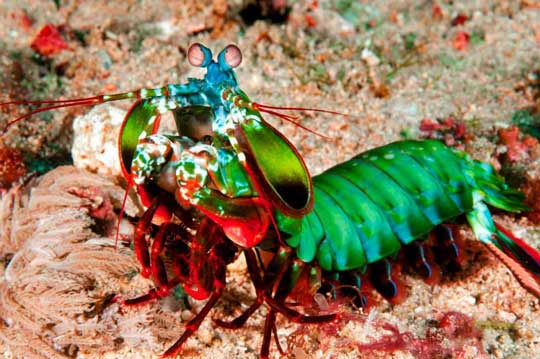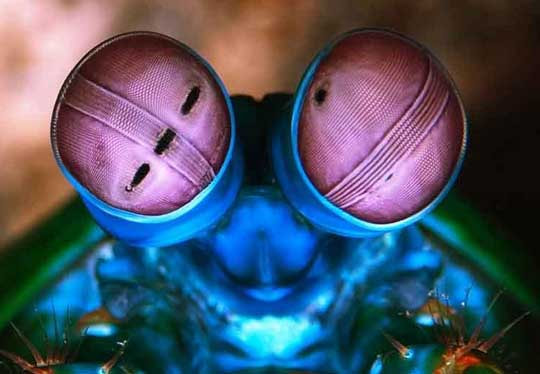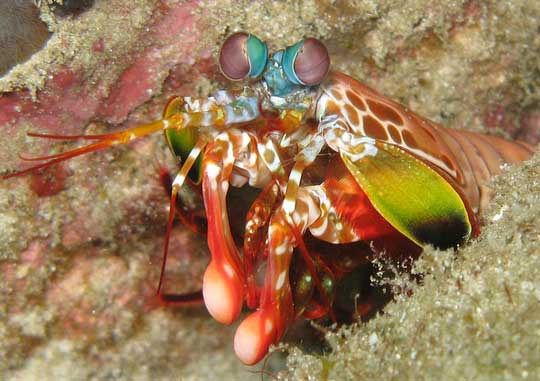|
Thanks to reader Daniel Hohlstein for suggesting this creature. Usually when we think of shrimp, we think, Yum... boiled or fried? But did you know that there are at least 3,000 species of crustaceans that are considered shrimp? As a group, they are extremely variable. But the prize for the most colorful has to go to the mantis shrimp (which, oddly enough, isn't actually a true shrimp). But their colors are not the most impressive thing about mantis shrimp. If you are ready to be amazed, read on. What the heck is a Mantis Shrimp? You know what arthropods are, right? Arthropoda is a phylum of animals that includes pretty much all the invertebrates that have an exoskeleton (insects, crabs, spiders, centipedes, scorpions, isopods, and many more). In Bridgers 4, Infinity and Desmond are stranded on a world filled with amazing arthropods. Within the arthropod phylum, we have the subphylum of crustaceans (crabs, shrimp, lobsters, crayfish, isopods, barnacles, and more). And then within the crustaceans we have an order called Stomatopoda. The stomatopods include about 450 species of mantis shrimp. Perhaps the most striking thing about mantis shrimp is that they are deadly predators. Fierce, wicked, dangerous, clobbering predators, capable of smashing their prey to smithereens. Amazing facts about Mantis Shrimp Before we discuss the predator behavior of mantis shrimp, let's talk about their colors. Why do mantis shrimp have such amazing colors? It probably has something to do with the fact that they have amazing EYES. It's true. Mantis shrimp are considered to have the most impressive and complex eyes of the entire animal kingdom. Perhaps you think I'm exaggerating, so let's take a look. You know how human eyes have rods and cones, right? Rods are for detecting movement and light levels. Cones are for detecting color. Animals that have lots of rods (like deer) are very good at detecting movement. Animals with lots of cones are good at detecting colors. Humans have pretty good color vision, but we have only three types of cones (dogs, on the other hand, have only two types of cones). Think about how colorful the world looks to us with our three types of cones. Now imagine what it would look like if we suddenly had FIVE types of cones (like some butterflies). We would then see colors that we don't even have words for—colors we've never seen before. Okay, now imagine what the world would look like if we had SIXTEEN different types of color-sensing cones. Because that's how many mantis shrimp have! If a mantis shrimp suddenly had to look through human eyes, it would probably think our vision is pretty darn plain and boring. When you and I look at a peacock mantis shrimp, here's what we see: Now try to imagine what another mantis shrimp would see, with its SIXTEEN types of cones. It boggles the mind. Let's explore these eyes a bit more. The mantis shrimp's eyes are on stalks and can move freely and independently of each other. Each eye is packed with tens of thousands of clusters of cones (photoreceptor cells). And those cells are divided into three regions: the top, the bottom, and a band of special cells across the middle (see photo below). These three regions are different, and mantis shrimp can look at objects with all three regions at the same time, giving them super-duper trinocular vision! And they can see wavelengths of light we cannot see at all. For example, they can see deep ultraviolet. They can actually detect five different frequency bands in the deep ultraviolet range. And they can see two types of polarized light (linear and circular), an ability that has never been observed in any other animal. We cannot see any of these frequencies, so we can only imagine what things look like to a mantis shrimp. Consider the three regions in each eye above. Since there are two eyes, that's six regions, each of which can look at an object separately. Humans have two eyes, and with our two eyes we have decent depth perception. But mantis shrimp can look at things with all six regions at once, giving them far better depth perception. Which helps to make them the awesome predators they are. One more thing about the eyes. Recent studies have shown that mantis shrimp can actually detect cancer. How? Their eyes see polarized light, and polarized light is reflected differently by cancerous cells compared to healthy cells. This is leading to attempts to replicate this ability with cameras that use specialized lenses that can detect polarized light in the same way. Now let's get back to talking about the mantis shrimp's amazing ability to pulverize the crap out of its prey. These creatures have modified forelimbs, or "clubs." These clubs are highly-specialized, calcified limbs that are generally divided into two categories: those for impaling their prey, and those for smashing their prey. So, the 450 species of mantis shrimp are divided into smashers and spearers (I'm not kidding). Both of these types have the ability to strike out with unbelievable power. See the two clubs at the bottom of the photo below: Just how powerful are these clubs (or spears)? Well, you might think I'm exaggerating, but let's take a look. Mantis shrimp strike by rapidly unfolding their clubs. From a standing start, the club instantly reaches a speed of 51 miles per hour (83 km/hr). This requires an acceleration of 10,400 Gs. Think about this: One G is the gravitational force pulled on objects by the Earth's gravity. So right now, sitting in my chair, I am experiencing one G of force (the Earth's gravity is what makes my body weigh 185 pounds when I am sitting still). If I accelerate straight up at 2 Gs, my body would seem to weigh 370 pounds. AND... if I accelerate at 10,400 Gs, my body would seem to weigh nearly 2 million pounds! In other words, I would be smashed into disgusting Stan C. Smith soup. I repeat, the mantis shrimp accelerates its clubs at 10,400 Gs. Those little clubs accelerate faster than a 22 caliber bullet being fired from a rifle. So when they hit something, they hit it REALLY hard. Not only that, but the rapid acceleration of their clubs causes tiny, superheated, vapor-filled bubbles to form in the surrounding water. These are called cavitation bubbles, and when these bubbles suddenly collapse, this creates another significant force on the prey—enough force to shatter the prey's body. So even if the mantis shrimp misses its prey, the force from the collapsing cavitation bubbles will likely do the job. And mantis shrimp can strike quickly. They swing out their clubs in less than 800 microseconds. This means that, theoretically, in the time it takes you to blink an eye, these shrimp can punch you 500 times. But it usually only takes a punch or two to do the job. Check out this video showing the mantis shrimp's smashing ability. If you could swing your arm with the same force as a mantis shrimp, you could throw a baseball into orbit. Mantis shrimp are not usually kept in glass aquariums because they are capable of shattering the aquarium's glass walls. Mantis shrimp literally bash their prey to bits and then feed on the mess of dismembered legs and body parts. Hmm... I need to figure out how to integrate some kind of giant mantis shrimp into Bridgers 6. Okay, so here's a good question. If mantis shrimp can punch so hard, how can they do this without breaking their own appendages? Scientists have looked closely at their clubs and it turns out that the outer surface consists of a hard crystalline calcium-phosphate ceramic material. But it's the layers beneath that make all the difference. The clubs have layers of elastic polysaccharide chitin, which act as shock absorbers and prevent the clubs from cracking. This stuff is so impressive that engineers are using the concept to build new types of aircraft panels and body armor. So, the mantis shrimp deserves a place in the O.A.H.O.F. (Outasight Animal Hall of Fame). FUN FACT: The word outasight is obviously a reduction of out-of-sight. Out-of-sight is a slang term that originated in about 1890. Wait! What? I bet you thought it originated as a hippie phrase in the 1960s, right? Along with the related phrase far out. But it's actually much older than this. Here's an excerpt from the 1893 novel, Train Wreckers: "Now if Daisy would only put in an appearance this would be an out of sight chance to pop the question." Of course, the phrase DID become very popular in the 1960s, when it was derived from far out (that Bridgers 5 book is so far out that it's out of sight!), and is usually associated with the experiences of using psychedelic drugs. Either way, the phrase is a perfect fit for the mantis shrimp, don't you think? So, outasight is another way to say awesome! Photo Credits:
Peacock Mantis Shrimp #1 - George Grall, National Aquarium Peacock Mantis Shrimp #2 - Imgur Mantis Shrimp Eyes - Awesci Science Everyday Mantis Shrimp clubs - Wikimedia Commons via Discover Magazine Mantis Shrimp #3 - Ian Rosner
0 Comments
Leave a Reply. |
Stan's Cogitations
Everyone needs a creative outlet. That's why I write. Archives
July 2024
|






 RSS Feed
RSS Feed